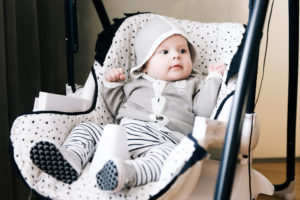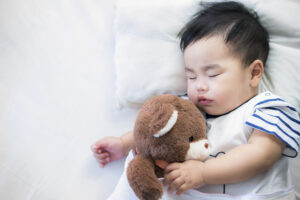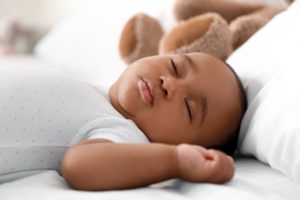When you buy through our links, we may earn a commission. Products or services may be offered by an affiliated entity. Learn more.
Newborn Wake Windows: What’s Normal?
Bringing home a newborn is exciting, but can also be stressful. If you’re like many parents and caregivers, you may worry about whether your baby is sleeping normally. Understanding infant sleep patterns, including newborn wake windows, can help you know what to expect and put your mind at ease.
What Are Newborn Wake Windows?
A newborn wake window is the period of time that a newborn baby is awake between naps. A wake window begins when a baby wakes up and ends the next time they fall asleep. Newborns have multiple wake windows each day and night . Having short wake windows as little as 30-45 minutes and as much as 90 minutes is part of normal development at this age.
Do Wake Windows Help a Baby Sleep?
Wake windows and naps go hand-in-hand, and both are important parts of a baby’s development. For newborns, there’s no need to try to extend wake windows to try to lengthen sleep periods, as most infants will do this independently. However, it is important for parents to be aware of these transitions so that they may help their infants stay on track and not extend the wake window inadvertently.
Most babies have short periods of being awake and asleep throughout the day and night and do not begin getting more of their sleep at night until they are 4 to 6 months old. Some babies may have difficulty sleeping all the way through the night until they are 1 year old or older, but often the ease at which a child can sleep through the night is determined, in part, by how much sleep and calories are received during the day as well as sleep onset associations that are developed. Parents have little ability to affect how quickly babies start sleeping through the night.
Estimated Wake Windows By Baby Age
Every infant is different and operates on their own schedule, so your baby’s wake windows may look different than another’s and can actually change from one day to the next. Among newborns especially, unpredictable sleep is completely normal. It is important to keep that in mind when considering the general range of wake windows by age.
| Baby’s Age | Wake Window Length |
|---|---|
| 0 to 1 month | 0.5 to 1.5 hours |
| 1 to 4 months | 1 to 3 hours |
| 5 to 7 months | 1.5 to 4.5 hours |
| 7 to 10 months | 1.5 to 6 hours |
| 10 to 12 months | 3 to 7.5 hours |
When to Stop Using Wake Windows
Parents and caregivers often stop thinking in terms of specific wake windows once their child is only taking one or two naps per day. Babies gradually take fewer naps each day as they grow older .
Between 12 and 18 months, most children start napping two or fewer times per day. However, some may continue to nap more than twice a day until they’re 3 or 4 years old.
What to Do During Wake Windows
Newborns need to be fed and have their diapers changed during their waking hours. Since newborns have relatively short wake windows, you’ll typically have plenty to take care of while they’re awake.
Wake windows are a great time to bond with your infant by holding and talking to them. Experts also recommend daily “tummy time,” a period in which you supervise your baby while they lie awake on their stomach .
Ending a Wake Window
At the end of a wake window, it’s time to put your baby back to sleep. You can end the wake window by putting your baby in their crib in a dark room. Add a pre-sleep routine so the infant starts associating sleep with those routines, for example, going into a dark room, reading a book, singing a song, getting the swaddle on, cuddling briefly, and then putting them into the crib awake.
Experts advise against intentionally having your baby fall asleep in your arms. Getting a baby accustomed to falling asleep in their own crib may help develop sleep habits that, in the future, will help your child get back to sleep on their own if they wake up during the night.
If you’re ending a longer wake window, think about whether your baby has eaten recently. If not, feed them so that hunger doesn’t cause them to quickly awaken. However, make sure they are not feeding to sleep so that an association between feeding and sleeping does not develop. You may also want to change their diaper and put them in a sleep sack or other warm clothes. Once they begin sleeping more at nighttime, you can create an overnight sleep routine that could involve a bath, rocking, singing, or reading a book to end their evening wake window.
The safest way to put your baby to sleep is on their back. Avoid putting your baby on their stomach or side to sleep because these positions are linked to a higher risk of sudden infant death syndrome (SIDS). Also, keep their crib clear of pillows, heavy blankets, and toys, all of which may interfere with their ability to breathe freely.
Signs a Baby Is Tired
You know it’s time to end a wake window when your baby is showing signs of tiredness. When a baby is getting tired, they may:
- Cry
- Yawn
- Rub their eyes
- Blink more frequently
- Stare off to the side
Your baby may also have their own unique signs of tiredness that you notice over time. If your baby often shows these signs at a certain point into a wake window, you may want to begin laying them down to sleep a few minutes before they get excessively tired or distraught.
How Much Sleep Does a Baby Need?
Both the American Academy of Sleep Medicine (AASM) and the National Sleep Foundation (NSF) provide guidelines on how much sleep a baby needs . The recommended amounts of sleep include both nighttime sleep and daytime naps across a 24-hour period. If your baby is sleeping considerably more or less than the ranges listed for their age, talk to your pediatrician.
| Baby’s Age | Recommended Sleep Over Each 24-Hour Period, Including Naps |
|---|---|
| Newborns (0 to 3 months) | 14 to 17 hours |
| Infants (4 to 12 months) | 12 to 16 hours |
| Toddlers (1 to 2 years) | 11 to 14 hours |
How Many Naps Does a Baby Need?
Newborns may take six or more naps per day . The number of naps a baby takes each day gradually decreases as they get older until they eventually only nap once or twice per day – which may be closer to two years of age.
Different babies require a different number of naps each day, so it’s best to pay attention to when your baby seems tired. Since there’s no uniform number of naps that’s best for every baby, focus on what works for your child and allows them to get sufficient sleep each day.
Do Sleep Regressions Affect Wake Windows?
Sleep regressions are sudden and disruptive changes in your baby’s sleep patterns, and they can affect wake windows. During a sleep regression, a baby may seem to revert to a sleep pattern that they had at a younger age. As a result, they may suddenly start to have shorter or longer wake windows.
Experts suggest that sleep disturbances may be more common around 9 months and 18 months of age. Around these ages, sleep may be thrown off by a child’s growing ability to move around or feelings of separation anxiety. Long naps in the late afternoon or too much stimulation before bed can also interfere with the ability of children of this age to sleep soundly throughout the night.
When to Talk to Your Doctor
If you feel worried about your baby’s sleep patterns, share your concerns with your pediatrician. Specifically, talk to your doctor if your child isn’t getting the recommended amount of sleep for each 24-hour period for their age group. Your doctor can help you determine if your baby has healthy sleep patterns or if there might be an underlying issue affecting their sleep.
While uncommon, babies can have sleep disorders , such as restless legs syndrome (RLS) and obstructive sleep apnea (OSA). If you observe snoring or thrashing during sleep, mention it to your doctor. As children grow older, nightmares, night terrors, and sleepwalking can also occur. They usually don’t require treatment, but you can bring them up with the doctor if you have concerns.
Help Your Baby Sleep Better With Pediatric Sleep Coaching

our partner at sleepdoctor.com
Learn More“Life-changing! My anxiety about my son’s sleeping habits were immediately reduced after talking to Sara. She went above and beyond to tailor a schedule to our goals, answer our questions, keep us on track, and check in to encourage us when we just thought we couldn’t do it anymore.”
Rachael B. – Verified Customer

Still have questions? Ask our community!
Join our Sleep Care Community — a trusted hub of sleep health professionals, product specialists, and people just like you. Whether you need expert sleep advice for your insomnia or you’re searching for the perfect mattress, we’ve got you covered. Get personalized guidance from the experts who know sleep best.
References
8 Sources
-
Consolini, D.M. (2023, September). Sleeping behaviors in newborns and infants. Merck Manual Consumer Version.
https://www.merckmanuals.com/home/children-s-health-issues/care-of-newborns-and-infants/sleeping-behaviors-in-newborns-and-infants -
UpToDate. (n.d.). Patient education: How to put your baby down to sleep (the basics).
https://www.uptodate.com/contents/how-to-put-your-baby-down-to-sleep-the-basics -
Staton, S., Rankin, P. S., Harding, M., Smith, S. S., Westwood, E., LeBourgeois, M. K., & Thorpe, K. J. (2020). Many naps, one nap, none: A systematic review and meta-analysis of napping patterns in children 0-12 years. Sleep Medicine Reviews, 50, 101247.
https://pubmed.ncbi.nlm.nih.gov/31862445/ -
Task Force on Sudden Infant Death Syndrome (2016). SIDS and other sleep-related infant deaths: Updated 2016 recommendations for a safe infant sleeping environment. Pediatrics, 138(5), e20162938.
https://pubmed.ncbi.nlm.nih.gov/27940804/ -
Paruthi, S., Brooks, L. J., D’Ambrosio, C., Hall, W. A., Kotagal, S., Lloyd, R. M., Malow, B. A., Maski, K., Nichols, C., Quan, S. F., Rosen, C. L., Troester, M. M., & Wise, M. S. (2016). Recommended amount of sleep for pediatric populations: A consensus statement of the American Academy of Sleep Medicine. Journal of Clinical Sleep Medicine, 12(6), 785–786.
https://pubmed.ncbi.nlm.nih.gov/27250809/ -
Hirshkowitz, M., Whiton, K., Albert, S. M., Alessi, C., Bruni, O., DonCarlos, L., Hazen, N., Herman, J., Adams Hillard, P. J., Katz, E. S., Kheirandish-Gozal, L., Neubauer, D. N., O’Donnell, A. E., Ohayon, M., Peever, J., Rawding, R., Sachdeva, R. C., Setters, B., Vitiello, M. V., & Ware, J. C. (2015). National Sleep Foundation’s updated sleep duration recommendations: final report. Sleep Health, 1(4), 233–243.
https://pubmed.ncbi.nlm.nih.gov/29073398/ -
Figueiredo, B., Dias, C. C., Pinto, T. M., & Field, T. (2016). Infant sleep-wake behaviors at two weeks, three and six months. Infant Behavior & Development, 44, 169–178.
https://pubmed.ncbi.nlm.nih.gov/27448323/ -
Sulkes, S. B. (2023, May). Sleep problems in children. Merck Manual Consumer Version.
https://www.merckmanuals.com/home/children-s-health-issues/behavioral-problems-in-children/sleep-problems-in-children





























